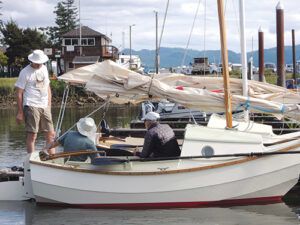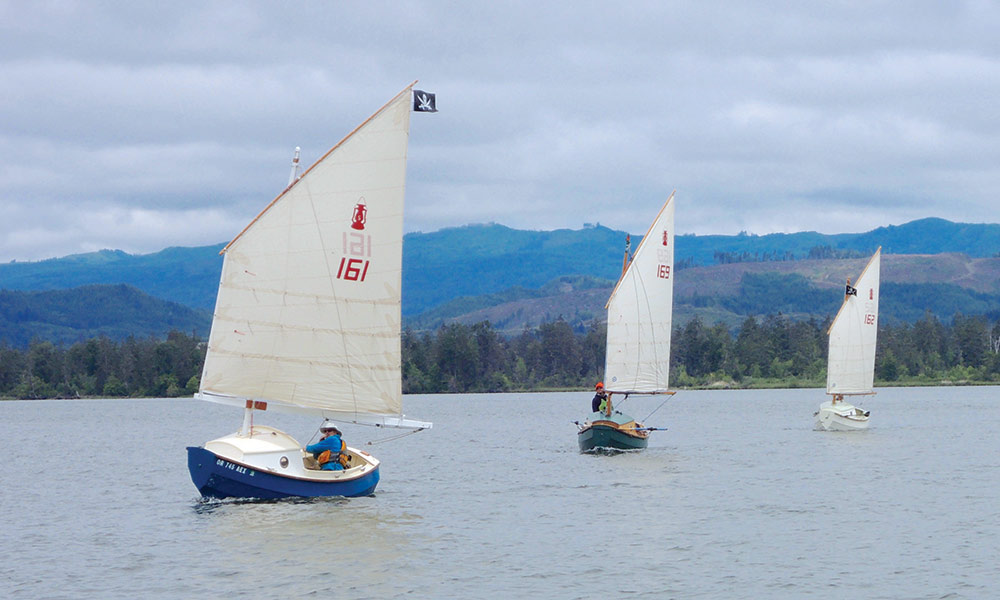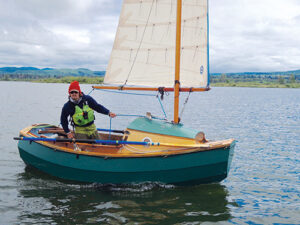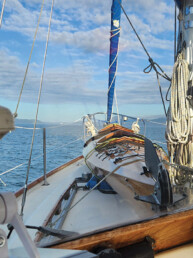
When I first saw a Scamp sailboat, I thought it looked like an oversized children’s bath toy. It seemed to bob around sitting too high in the water, and that snub nose made me feel that part of the boat was missing. But once aboard, the high sides created a dry ride and an atmosphere of safety. With a small cuddy forward, and lots of hatches for neatly stowing gear, it felt serene compared to some of the open boats I normally admire, where gear and stray equipment clutter their cockpits.
The Small Craft Advisor Magazine Project (better known as SCAMP) is an increasingly popular small sailboat that can be built from plans or a kit, as well as ordered as a ready to sail fiberglass model constructed locally by Gig Harbor Boat Works. With a 100-square-foot sail, and measuring just shy of 12 feet with a beam of about five feet, the boat seems like it shouldn’t sail well at all, but somehow it does.
I’ve been out on Scamps enough times to not be surprised by their abilities. For such a small boat, I’m continually impressed by how comfortable and spacious the seven-foot long cockpit, with benches lining each side, and the five-foot cuddy make the boat feel. If I was blindfolded at the helm of a Scamp and you asked me how big a boat I was steering, I’d say something long and steady — maybe 20 feet. After all, I’d be sitting straight up, with my legs down in a well, not scrunched up like most dinghies. The tiller in hand would feel steady, with no signs of the boat wiggling due to any slight inattention.
I wasn’t alone in finding the aesthetics of the hull curious. “I became interested in Scamps very slowly. At first I did not really care for them,” my pal Randy Wheating wrote by email. “However, my big Chebacco was being used less and less.”
Many people construct their own Scamps as part of a class. Friend and lifelong sailor, Dale Simonson, told me, “I sort of ended up with a Scamp by mistake. Or, more like by happenstance. I was planning (or dreaming about planning) to build a boat in a few years… when I stumbled onto an upcoming ‘Scamp Camp,’ a group build of ten boats. Ten students, four instructors, two weeks, and come home with your own boat!”
Dale noted, “I wasn’t totally enamored with the design until I started to really consider the value of the workshop, and getting such a good jumpstart on a build. It wasn’t until we got into the build, and all the ensuing discussions with the instructors (in particular, John Welsford the designer, and Howard Rice the adventure sailor), that I fell in love with the concept and the approach of the design as a very small vessel that is capable of cruising my local near-shore waters of the Salish Sea.”
For some Scamp sailors, the camaraderie is a big part of the appeal of the boat. There’s an active online community as well as Red Lantern rallies where scads of Scamps congregate. But that’s not true for everyone. Samantha Ritchie, the captain of a fiberglass Scamp named Kerfuffle observed, “the Scamp community is mostly older white men. I like older white men, but that’s not really my group, so I am not into the ‘community’ thing very much. That being said, I love seeing other Scamps and always go chat with the owners.”
But like other people, Samantha appreciates the balance of simplicity and function. “I am very comfortable in the Scamp, and it’s a low fuss kind of boat. I am strong for a 65-year-old woman, but not as strong as I was 10 years ago. Despite that, I can easily put up the mast, pull the boat up on a beach, etc. No need for winches for any big jib — no jib!”

I initially expected the Scamp to sail like a bulldozer, slogging along pushing water. In reality, it moves smoothly under sail and turns on a dime, making sailing out of a marina or around other tight places deceptively easy. With only one sail and a short waterline, making 360 degree penalty turns actually feels like fun. I will admit one fault about my crush — as I’ve sailed alongside my friends in their Scamps, they are gradually outpaced by all but the shortest hulls.
I’ve been out in Scamps in a big blow, but when filled with 175 pounds of water ballast (integrated into cavities in the hull), I’ve been impressed with how stable they were. But, it wouldn’t be a sailboat if you didn’t get scared from time to time and yes, despite the broad beam and reefable sail, I’ve seen them capsize. Still, the boat is self rightable and floats high enough to bail with a little effort.

Besides being fun to sail, the Scamp is an able camp cruiser and despite its size, both Dale and Samantha have done overnight stints at anchor with their partners. Dale notes, “I think I’m a minimalist at heart, my wife and I lived in Volkswagen vans for two years, touring Europe and Australia. I love to row (and sail, even more) and don’t care much for motor boating. I have found backpacking, kayaking, camping, and living a bit ‘rough’ to be enjoyable… Big poofy pillows are allowed. Dutch ovens, too. It’s a very comfortable floating tent that turns into a kitchen, a lounge, and then a fun sailing machine… and fits in a single car garage.”
As I’ve started to play with the many strings and sticks attached to slightly larger boats, the simplicity of the Scamp keeps calling me. Sure I’d be slower and maybe not as sleek, but the comfort and adaptability of the Scamp in such a small package just keeps me smiling.
Bruce Bateau sails and rows traditional boats with a modern twist in Portland, Oregon. His stories and adventures can be found at www.terrapintales.wordpress.com.
Bruce Bateau
Bruce Bateau sails and rows traditional boats with a modern twist in Portland, Ore. His stories and adventures can be found at www.terrapintales.wordpress.com






